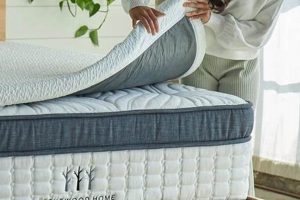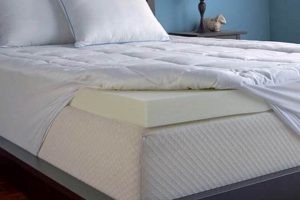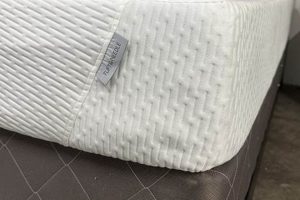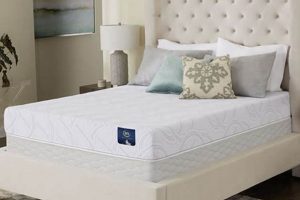A portable sleep surface designed for enhanced comfort during transit, these items utilize viscoelastic foam to conform to the body, providing pressure relief and support. These products are typically compact and lightweight, facilitating ease of transport and storage when not in use. For example, individuals on extended trips or temporary assignments may employ such a sleeping solution to mitigate discomfort associated with unfamiliar bedding.
The significance of a comfortable and supportive sleeping surface while traveling stems from its impact on rest quality and overall well-being. Such surfaces can improve sleep, reduce aches and pains, and contribute to a more productive and enjoyable travel experience. The advent of these portable sleep solutions aligns with increasing awareness of the importance of sleep hygiene and the desire to maintain consistent comfort levels regardless of location.
The subsequent sections will delve into the construction, benefits, considerations for selection, and maintenance of these portable sleeping solutions, offering a comprehensive overview for informed decision-making.
Guidance on Compact Viscoelastic Mattresses
The following offers practical advice for maximizing the utility and lifespan of a portable viscoelastic mattress, ensuring comfortable and restorative rest while traveling.
Tip 1: Consider Density. The density of the foam influences its support and durability. Higher density materials generally offer greater support and resistance to compression, which is beneficial for extended use.
Tip 2: Assess Dimensions and Weight. Prior to purchase, accurately measure available space within luggage or vehicles. Evaluate the weight to ensure manageable portability during travel.
Tip 3: Prioritize Breathability. Viscoelastic foam can retain heat. Seek models incorporating ventilation channels or breathable covers to mitigate heat buildup and promote airflow.
Tip 4: Evaluate Cover Material. The cover should be durable, washable, and hypoallergenic. Consider materials such as bamboo or organic cotton for enhanced breathability and reduced allergen exposure.
Tip 5: Test for Off-Gassing. Some viscoelastic foam products emit volatile organic compounds (VOCs). Allow the mattress to air out in a well-ventilated area before initial use to minimize potential odors.
Tip 6: Implement Proper Storage. When not in use, store the mattress in a dry, cool environment, preferably in its original packaging or a protective bag, to prevent dust accumulation and potential damage.
Tip 7: Rotate Regularly. Periodically rotate the mattress to distribute wear evenly, which can extend its lifespan and maintain consistent support.
Adherence to these guidelines can significantly enhance the longevity, comfort, and hygienic properties of this travel accessory, leading to improved rest quality while away from home.
The subsequent sections will offer information about purchase considerations and detailed maintenance procedure.
1. Density and Support
Density, in the context of a viscoelastic travel mattress, directly correlates with its capacity to provide support. Higher density signifies a greater concentration of viscoelastic material per unit volume. This increased material concentration translates to enhanced resistance to compression, yielding improved support for the user’s body weight. The consequence of inadequate density is often insufficient spinal alignment, leading to discomfort and potential musculoskeletal strain. Conversely, a suitably dense surface distributes pressure more effectively, reducing the likelihood of pressure points and promoting restful sleep.
Consider two scenarios: An individual using a low-density viscoelastic travel mattress experiences sinking and a lack of support, resulting in back pain. Another individual utilizing a high-density mattress experiences evenly distributed support, maintaining proper spinal alignment and promoting comfortable rest. This contrast underscores the practical significance of density as a critical component. This aspect is particularly important for side sleepers, who require adequate shoulder and hip support to prevent spinal curvature.
The interplay between density and support represents a foundational aspect of selecting an appropriate sleeping surface. Compromising on density can negate the purported benefits of the viscoelastic material. While considerations such as portability and cost are relevant, neglecting the density-support relationship results in a product that fails to fulfill its primary function of providing comfortable and restorative sleep. Understanding this relationship equips consumers to make informed purchasing decisions, prioritizing quality and long-term ergonomic benefits.
2. Portability and Weight
The inherent utility of a viscoelastic travel mattress hinges significantly on its portability and weight characteristics. The primary function of such an item is to provide enhanced sleep comfort during travel; therefore, its ease of transport becomes paramount. Excessive weight or unwieldy dimensions negate the benefits by creating logistical challenges. For instance, an individual traveling by air with restrictive baggage allowances will find a bulky, heavy mattress impractical. Conversely, a lightweight and compact mattress can be easily integrated into luggage, facilitating comfortable rest without undue burden.
The relationship between portability and weight and overall convenience is a direct one. A lighter mattress reduces physical strain during transport, which is particularly relevant for travelers with physical limitations or those navigating crowded spaces. Moreover, compact dimensions enable easier storage within vehicles, tents, or temporary accommodations. The design and materials directly affect the portability. Closed-cell structures generally result in heavier material, and open-cell structures generally offer more breathability. The choice and balance are very important for consumers’ requirements.
In summary, the portability and weight of a viscoelastic travel mattress are not merely superficial attributes but rather integral components affecting its practical value. A design that prioritizes lightweight construction and compact dimensions ensures that the mattress serves its intended purpose effectively, enhancing travel comfort without imposing unnecessary burdens. The balance of comfort, support and portability will be a concern of a traveler.
3. Size and Dimensions
The physical size and dimensions of a viscoelastic travel mattress signi
ficantly impact its usability and convenience, particularly when considering the constraints of travel and temporary living arrangements. Selecting an appropriate size ensures optimal comfort while conforming to spatial limitations.
- Compatibility with Sleeping Space
The mattress dimensions must align with the available sleeping area, whether it be a tent, vehicle, or temporary lodging. Incompatibility can lead to discomfort and restricted movement during sleep. For example, a mattress that is too wide for a tent will be unusable, while one that is too short may leave extremities unsupported.
- Foldability and Storage
The ability to fold or compress the mattress into a compact form is crucial for efficient storage and transport. Mattresses designed with multiple folding points or compressible materials offer a practical advantage. A mattress that cannot be easily folded may require a larger storage space, adding burden to travel arrangements.
- Conformity to Body Size
The length and width of the mattress should accommodate the user’s body dimensions to ensure adequate support for the entire body. Insufficient length can result in discomfort and compromised sleep quality. For taller individuals, standard-sized mattresses may prove inadequate, necessitating a larger model.
- Weight Distribution
The overall dimensions influence weight distribution across the sleeping surface. A larger surface area distributes weight more evenly, reducing pressure points. A smaller surface area may concentrate weight in specific areas, potentially leading to discomfort. For example, a broader mattress allows for more even distribution of weight across the shoulders and hips when sleeping on one’s side.
In conclusion, the size and dimensions of a viscoelastic travel mattress are critical factors influencing its suitability for travel. Careful consideration of spatial constraints, portability requirements, and the user’s body size ensures that the chosen mattress effectively balances comfort and convenience.
4. Hygiene and Maintenance
The hygienic upkeep of a viscoelastic travel mattress is inextricably linked to its longevity and the user’s health. Regular maintenance practices mitigate the accumulation of allergens, dust mites, and microorganisms, all of which can compromise the sleeping environment.
- Surface Cleaning Protocols
Consistent surface cleaning, typically involving gentle vacuuming and spot treatment with mild detergents, removes surface-level contaminants. Infrequent cleaning allows for the proliferation of dust mites and the accumulation of dead skin cells, creating an unsanitary environment. For instance, failing to address a spill promptly can lead to mold growth within the foam structure, necessitating replacement.
- Protective Cover Utilization
The employment of a washable, hypoallergenic cover serves as a critical barrier against spills, stains, and allergens. This preventative measure significantly reduces the need for aggressive cleaning, which can degrade the foam over time. In practice, a quality cover can be easily removed and laundered, preserving the integrity of the mattress core.
- Ventilation and Moisture Control
Adequate ventilation following use prevents moisture accumulation within the foam, mitigating the risk of mold and mildew growth. Storing the mattress in a sealed container without allowing it to air out creates a conducive environment for microbial proliferation. Regular airing promotes evaporation and maintains a hygienic sleeping surface.
- Deep Cleaning Techniques
Periodically, a deeper cleaning involving specialized foam cleaners may be necessary to eliminate ingrained contaminants. However, the improper application of cleaning agents can damage the foam’s structure and compromise its performance. Careful adherence to manufacturer instructions is crucial to avoid degradation of the material.
The integration of these hygiene and maintenance practices directly influences the lifespan and sanitary condition of the travel mattress. Consistent attention to cleaning protocols and preventative measures ensures a healthier and more comfortable sleeping experience during travel. Neglecting these aspects not only diminishes the product’s utility but also presents potential health risks.
5. Durability and Longevity
The durability and longevity of a viscoelastic travel mattress are inextricably linked to its composition and intended usage. Material selection, construction techniques, and frequency of use directly influence its ability to withstand the rigors of travel and maintain its supportive properties over time. Inferior materials, such as low-density foam or poorly constructed seams, will result in premature degradation, rendering the mattress unsuitable for repeated use. For example, a mattress frequently compressed and stored improperly may exhibit permanent deformation, reducing its comfort and support.
The practical significance of durability and longevity lies in the economic and environmental considerations associated with replacement frequency. A mattress designed for enhanced durability represents a more cost-effective investment in the long term, mitigating the need for frequent replacements. Moreover, extending the lifespan of the product reduces waste generation and minimizes the environmental impact associated with manufacturing and disposal. Consider the scenario of a frequent traveler who purchases a mattress designed with robust materials and reinforced seams. This individual benefits from consistent comfort and support throughout numerous trips, avoiding the expense and inconvenience of replacing a less durable alternative.
In conclusion, the durability and longevity of a viscoelastic travel mattress are critical attributes directly impacting its value proposition. Prioritizing these characteristics ensures a reliable, comfortable, and environmentally responsible sleep solution for individuals on the move. While initial cost may be a factor, the long-term benefits of a durable and long-lasting mattress far outweigh the potential savings of a cheaper, less resilient alternative. The challenge remains in educating consumers on the importance of these qualities and providing transparent information on product composition and construction.
Frequently Asked Questions
The following addresses common inquiries regarding the application, selection, and maintenance of viscoelastic portable sleeping solutions. The information provided aims to clarify misconceptions and offer practical guidance.
Question 1: What distinguishes a travel version from a standard viscoelastic mattress?
Primary distinctions include reduced dimensions, lighter weight, and enhanced portability features, such as folding capabilities. Standard mattresses are designed for stationary use and lack these transport-oriented attributes.
Question 2: How does density influence the support characteristics?
Higher density translates to greater resistance to compression and improved weight distribution. This results in enhanced spinal alignment and reduced pressure points. Lower density may result in inadequate support.
Question 3: Are there any potential health concerns associated with off-gassing?
Some viscoelastic materials emit volatile organic compounds (VOCs). These can cause irritation in sensitive individuals. Adequate ventilation prior to initial use is advisable to mitigate potential adverse effects.
Question 4: What are the recommended cleaning procedures?
Regular vacuuming and spot cleaning with mild detergents are generally recommended. Harsh chemicals or abrasive cleaners should be avoided to prevent damage to the foam. Protective covers are also beneficial in reducing the frequency of intensive cleaning.
Question 5: How should the product be stored when not in use?
It should be stored in a dry, cool environment, preferably in a protective bag, to prevent dust accumulation and moisture absorption. Compressing the mattress for extended periods may result in deformation.
Question 6: What is the expected lifespan?
Lifespan varies depending on the material quality, frequency of use, and maintenance practices. Higher-quality mattresses with consistent maintenance can last several years. Degradation of support and shape indicate the need for replacement.
These FAQs offer a concise overview of critical considerations pertaining to these portable sleeping solutions. Informed decision-making requires a comprehensive understanding of these aspects.
The next section will delve into consumer considerations when choosing the right product.
Conclusion
This exploration of the memory foam travel mattress has underscored the importance of density, portability, size, hygiene, durability and how each attribute of a travel mattress influences its ability to provide adequate support, hygiene and meet the user’s needs, effectively balancing comfort and convenience. The critical balance between material quality, construction, and user habits determines its longevity and the maintenance requirements ensures continued hygiene.
The selection and responsible use of a memory foam travel mattress represent a commitment to prioritizing sleep quality amidst the demands of travel. Informed decision-making, guided by a thorough understanding of the aforementioned characteristics, ensures a sound investment that contributes to improved well-being and enhanced travel experiences. Continued technological advancements in materials science promise further innovations in this product category, offering the potential for even greater comfort, portability, and sustainability in the future.







